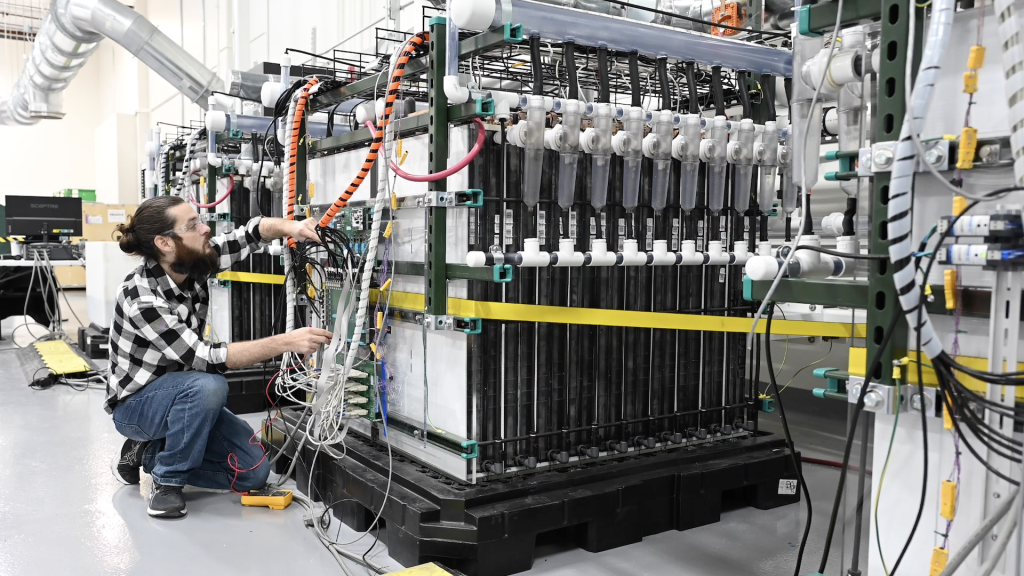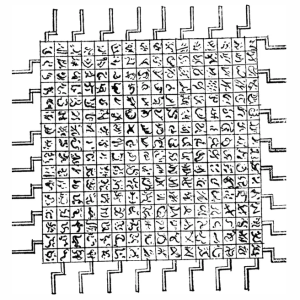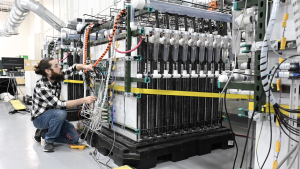“Air-batteries”

Photo from PBS.org: An electrical engineer works on Form Energy's 2022 battery module in the company's lab in Berkeley, California. Image courtesy of Form Energy
By Scott Hamilton
Once again I came across a great new technology coming out of an Israeli company. Augwind Energy is in the process of building the world’s first commercial-scale “air-battery” in Germany. They are using underground salt caverns to store compressed air for electricity generation. The battery’s construction is scheduled to be fully operational in late 2027 or early 2028. Using compressed air to store energy has been a concept for a long time, but the volume of air required to make it practical on a small scale is difficult to achieve.
Germany happens to be a great location due to the over 400 caverns suitable for AirBattery, and the country has the potential to store 330 trillion watt hours of power. To put it into perspective, your average car battery stores 100 watt hours, so it is the equivalent of 3.3 trillion car batteries. The estimated cost of an AirBattery installation is highly effective, costing around $15 per kWh, being environmentally friendly, requiring no special chemicals, and lasting over 40 years with no hardware degradation.
The initial project is to convert a single cavern to store between three and eight billion watt hours of electricity at a cost of four billion dollars. The technology works off of a really simple concept. You utilize locally sourced material to seal an existing natural cavern, or in this case an abandoned salt mine, to make it air tight. The cavern is then sealed and connected to an air turbine running off of clean energy sources, such as solar, wind or hydro-electric. The turbine forces air into the chamber and builds pressure, just like the air compressor in your garage.
The energy stored in compressed air on a large scale is much more efficient than the small tanks on the typical compressor, not to mention the compressor in your garage is limited to containing maximum pressures less than 300 pounds per square inch (psi) while the caverns are capable of storing much greater pressures, exceeding 2500 psi. Between the volume of air in the cavern and the extreme pressures, the caverns can store enough power to sustain an average city for several days. Tesla’s PowerWall batteries, designed to store enough power for the typical house for 24 hours, hold 100 kilowatt hours with an average cost of $16,000. So in order to achieve the same storage capacity of the cavern would require three million PowerWall batteries with an estimated cost of $48 billion. The equivalent system built with lithium batteries not only costs significantly more, but it has a much lower life expectancy of no more than 10 years.
This brings about a few really good questions. We have known about the ability to store energy in pressurized air for much longer than we have known about storing energy via chemical reactions, and yet our “latest” battery technologies all seem to be based on older technologies. What has taken us so long to actually open our eyes and mind to utilizing the ancient ways? The more I learn about our modern technologies, the more I begin to think that we have not really advanced at all; if anything we have gone backwards. We made a shift from using natural and observable mechanisms to store energy, to specialized and “invisible” technologies.
What I really mean to say is we have taken simple technologies that anyone can easily see working, and exchanged them for technologies that require advanced degrees in chemistry and physics to understand. A child as young as three-years-old understands that you can store and release energy by lifting an object and releasing it. The perfect example is the Hot Wheels tracks. They know that if they place one end of the track higher than the other and put a car at the top, it rolls down the track without having to push it. This is the basic concept behind modern gravity batteries. They know if they inflate a balloon and let it go, it flies around the room. This is the same mechanism used in the Israeli salt-air battery. You don’t need an advanced science degree to understand how the technology works.
We have chosen the invisible technology of lithium-ion batteries over the simple. You cannot see the electrons moving between the atoms within the lithium atoms, shifting between a positive charge on one end of the battery cell and the negative charge on the other. In fact it is even difficult to explain why it works; I guess it is kind of like an hour glass, the lithium ions get moved to the top of the hour glass during charging and fall to the bottom while the battery is discharging, but we cannot see the process, and batteries feel like magic.
Why has it taken us decades to realize that the old ways could be adapted to improve modern technologies? I personally think there is much more brilliance in seeing new uses for old technologies than in creating something “new” and “better.” Until next week, stay safe and learn something new.
Scott Hamilton is an Expert in Emerging Technologies at ATOS and can be reached with questions and comments via email to shamilton@techshepherd.org or through his website at https://www.techshepherd.org.






